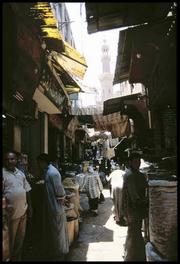
by Joe Morris
 |
| The spice market in Khan al-Khalili. |
"You want to see real Cairo market? I show you the real spice market," said the old man standing on a corner of Khan al-Khalili, the great bazaar of Cairo. Had it come from someone younger in a country with more lax laws, it might have sounded like a proposition for something illicit. This man, however, looked like he had lived in Cairo from before when its merchants learned English and started taking Visa. He was gray haired, with a slight stoop, and he made a nearly continuous chewing motion with his mostly empty gums. He was well dressed, however, and there was intelligence and vigor in his eyes and his manner. And we didn't really have any other plans for what to do with an afternoon in Cairo. The regular market looked rather bland and commercialized, and if there was a more authentic bazaar, we had nothing to lose by checking it out.
I was with a group of about five other travelers that I had met after we had all arrived in Luxor together at four in the morning. We had now arrived by overnight train in Cairo, and several moments before had just made it to Khan al-Khalili, in the oddly named district of "Islamic Cairo" - no more or less pious than the rest of the city, really. We were ostensibly looking for Fishawi's, a rather famous café in the center of the market, as a meeting point from which we would separate and regroup a couple hours later. In a navigational pause to discern which of the labyrinthine market streets we should take, someone turned and asked for directions, and got spice-market propositioned in return.
This was at least my fourth souq tour in the last several weeks, and I was by now content with my small hoard of goods to bring back. Istanbul's market is the best for all around quality of goods at cheap prices, particularly since the Turkish lira been vastly devalued recently. Damascus's Souq al-Hamidiyya is impressive because of the large curved tin roof that is suspended sixty feet above the street level. In Aleppo, wandering through the city, I stumbled across the meat market, where there are piles of heads of cattle, some kind of hooves, and all varieties of meat available hanging out on hooks, swarmed with flies.
Khan al-Khalili originally didn't seem to be much different: the most high-pressure salesmen worldwide hawking t-shirts, gold, and inlaid boxes for sale. Our guide, who introduced himself as Suleyman, led us down one of the smallest passageway into another street that was, in fact, the real spice market. It was a narrow stone walkway, with tightly packed shops. Each shop had bags and barrels of spices reaching from ten feet back in darkness of the back of the shop right out almost into the way of passers-by. The owners could usually be seen lurking in the back of their shop behind the scales used to tally purchases. Short Cairene women, normally out of sight, picked out and bagged supplies for their larders. The air dripped with the smells of cumin, turmeric and coriander, all smeared together to make the scent of the most powerfully-flavored falafel the world has even seen.
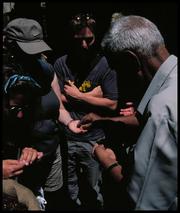 |
| Suleyman describes the two two colored, poisonous beads to us. |
Suleyman informed us that unlike the rest of the souq, there was no bargaining here; since there were virtually no tourists there were agreed-upon prices for everything. We paused at several merchants, and upon further inspection realized that the spices were not just powders, but also whole seeds, rocks, leaves, beads, and other substances that were difficult to categorize.
At each stop, Suleyman would pick up a handful of a substance and explain it's use and origin. There were frankincense and myrrh, which look like gummy rocks, made from gum of two related shrubs; they are both odorless unless burned. Here was indigo, sold as a vibrantly colored powder made from the fermented product of indigo plants. He took small seeds that were half black and half vivid orange and bid us each to keep them as good luck tokens, but to bear in mind that they were highly toxic -- never bothering to explain why the merchant had a barrel of them big enough to either bring great fortune to all the residents of Cairo, or poison them.
Most of the merchants were completely uninterested in selling us anything, which I took as a sign that we were off the tourist path. The few that could speak some English made halfhearted attempts to sell us saffron, which at one-fourth the price in America was their most expensive item.
I procured 100 grams of cumin, which is a lifetime supply for me -- most store-bought containers are about 50 grams -- and the shopkeeper almost seemed like he would rather not be bothered with selling such a small amount.
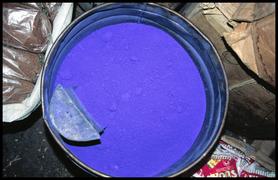 |
| A bucket of indigo. |
Eventually we ended up at the other end of the spice market. Suleyman informed us that, if we were interested, his shop happened to be nearby, where he sold fragrances. I had initially been suspicious of anyone giving free tours in this region, because they usually end up being free tours of the guide's wares, particularly in Egypt where shops are purported to be "museums" of papyrus or alabaster: museums where you can buy the exhibits. I was intrigued by this particular offer, however. I had seen several of these perfume shops around previously, and they usually bear more resemblance to a mad chemist's workshop than a place for fragrances. Additionally, Suleyman had taken a great deal of time with us already and explained things very well. So we went right on in.
Unlike the spice shops, which seemed to be constructed with whatever materials were available, Suleyman's perfume shop was made of well-worn hardwood from trees that had probably seen the better part of the nineteenth century. There were benches that ran most of the length of the shop - all of six feet - that barely accommodated the six of us. Suleyman sat behind a desk at the back wall. It was tiny, but the space was used efficiently, with four shelves ringed around his desk that were lined with vessels whose contents shone in an earth-toned rainbow, from pale yellow to dark amber and fifty shades in between.
His sometimes shaky hands steadied as they pulled down bottles from the shelves. Although there were groupings of bottles made of elaborate hand blown glass of many colors, the ones he chose were larger one-liter Pyrex bottles with ground glass stoppers. They were the kind I had previously been under the impression were only used in chemistry laboratories for concentrated acids and other toxic reagents. These, he explained, were filled with essential oils that design houses in Paris and New York mixed, diluted with ethanol, and marketed as Chanel No. 5 or Drakkar Noir.
He took the first bottle, one of the paler liquids, shook it and drew out the dripping stopper. He took my arm with a firmness that belied his age and inverted it, slathering copious amounts of oil on the inside of my wrist. As I raised my arm to sniff, my nose was filled with an usual smell that is simultaneously subtle but unmistakable after the first whiff, warm and sexy and somehow categorically different from other smells. It's more like it's coming up and caressing you rather than merely being smelled.
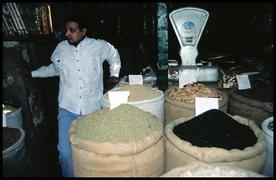 |
| A merchant in his shop with his bags of spices. |
"This is ambergris, the mother of all perfumes," explained Suleyman.
As Suleyman continued to abundantly and authoritatively distribute the scent to my companions, he explained that ambergris originates in the digestive tracts of sperm whales, and shows up as a waxy substance, in big floating chunks in the Indian and Pacific Oceans. Besides having a pleasant smell in its own right, it is also commonly used in perfumes as a binding agent, keeping other smells from evaporating quickly and wearing off; because of this property, it's a main ingredient in most major perfumes and colognes. Christian Dior's Poison is apparently the one that relies most heavily on the scent of ambergris itself. (I later learned that in order to fulfill demand, all of the ambergris-scent now used by most French perfume houses is synthetic. I have no idea where Egyptians actually get theirs from; Suleyman at least wanted us to believe that his stuff really came from the innards of a whale).
At this point, Suleyman's son entered the shop with tea, which is pretty common when you're talking or bargaining with a merchant in the Middle East. What was different here, though was that Suleyman opened up a small jar with an orange paste in it, which he informed us was a type of ambergris paste that is used to add flavor to tea, and bid us to take some of it and place it in our own tea. Suleyman informed us in an insinuating manner that often a Muslim man and his wife would drink the same beverage to, um, fire up the evening. Personally, I didn't think it was all that great; drinking the more concentrated form of ambergris made it much more believable that it came from the hindgut of a whale.
Next was musk, made from the scent glands inside the jaws of deer. Then "five secrets", which is a traditional mixture of essential oils that was adopted by Coco Chanel as Chanel No. 5. Suleyman told us one of them was ambergris but left the other four unknown, so it's more like "four secrets", really. Another was another musk derivative that is sold as Paco Rabanne. After he had distributed six different essential oils, he informed us that it would be irresponsible of him to give us any more; our noses would no longer be able to distinguish between them.
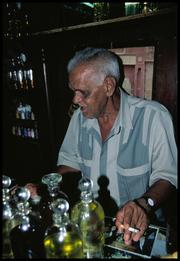 |
| Suleyman with the Pyrex bottles of essential oils. |
We also needed to stop because we had run out of real estate on our arms for any more oils to be slathered. At this point there was a great deal of re-smelling of different parts of our arms to decide on any purchases. Because Suleyman had cunningly used the same area of each persons arm for a particular smell, most of the discussion was along the lines of "what does the inside of your left elbow smell like again?" and "mmm I really like the right wrist one." After much debate, most everyone decided on ambergris, with a few five secrets dissenters. We each shelled out thirty Egyptian pounds (US$8) for two and a half ounce bottles that Suleyman filled from the big Pyrex bottles, one of the English women labeled, and Suleyman's son wrapped in a cocoon of scotch tape for safe travel.
We unpacked ourselves from the tiny shop, stretching and blinking as we emerged into the bright Cairo sun and the thick smell of thousands of spices, now with the addition of six perfumes wafting from us. Suleyman offered to now show us the way to Fishawi's, taking us back through the corridors of coriander and cumin, and eventually popping back out from the tiny side street of the spice market into the main pandemonium of Khan al-Khalili, where he gave us a few final directions and we waved goodbye.
The main market now seemed even more trite than before, with "Egypt" shirts blaring multi-hued hieroglyphics at us from behind stacks of pyramid-shaped paperweights, as vendors aggressively came up and tried to sell us everything from silver ankhs to water pipes, in stark contrast to their more somber spice-merchant brethren. We wandered on towards the café, wafting a cloud of pleasant perfume smells behind us, knowing we had seen something more off the beaten path.

| xenotropic.net | email/publickey | licensing |